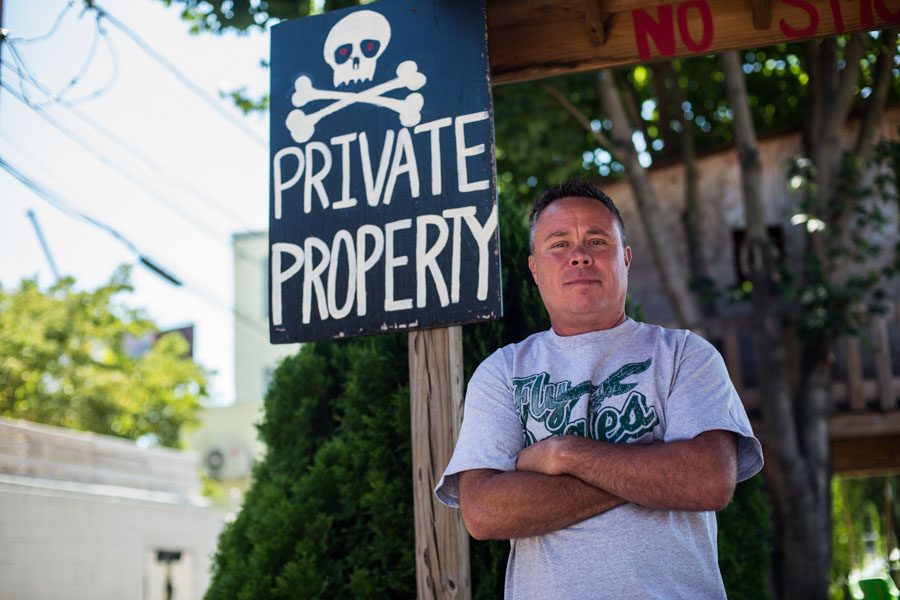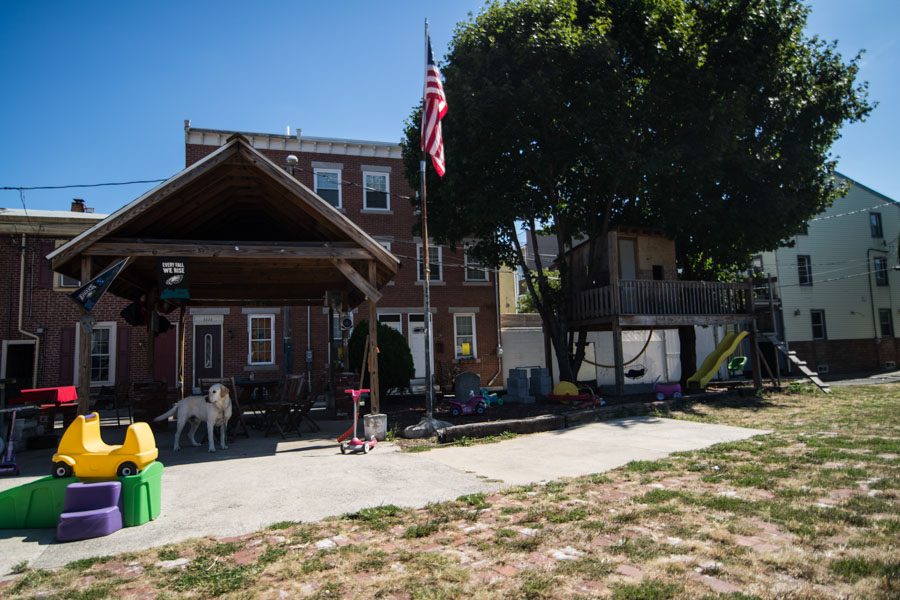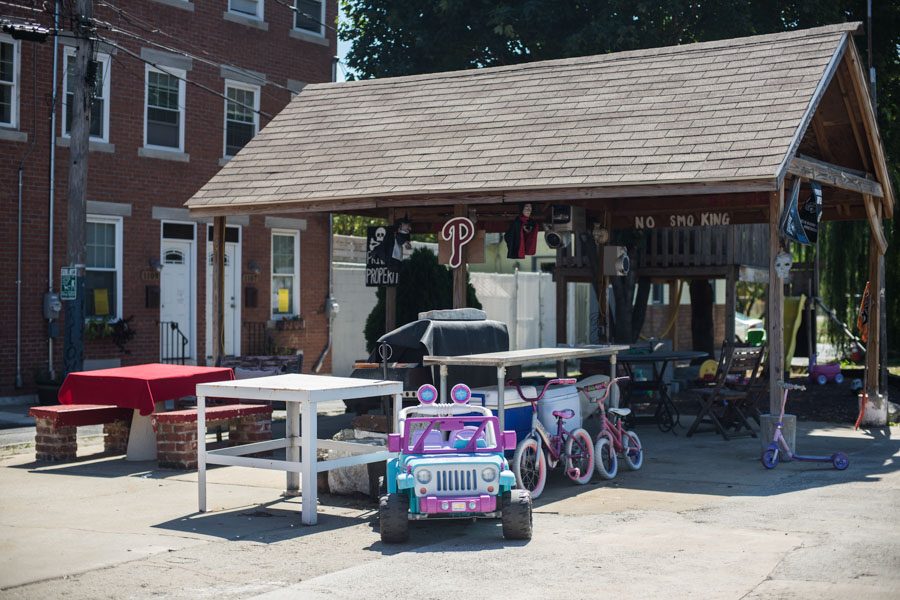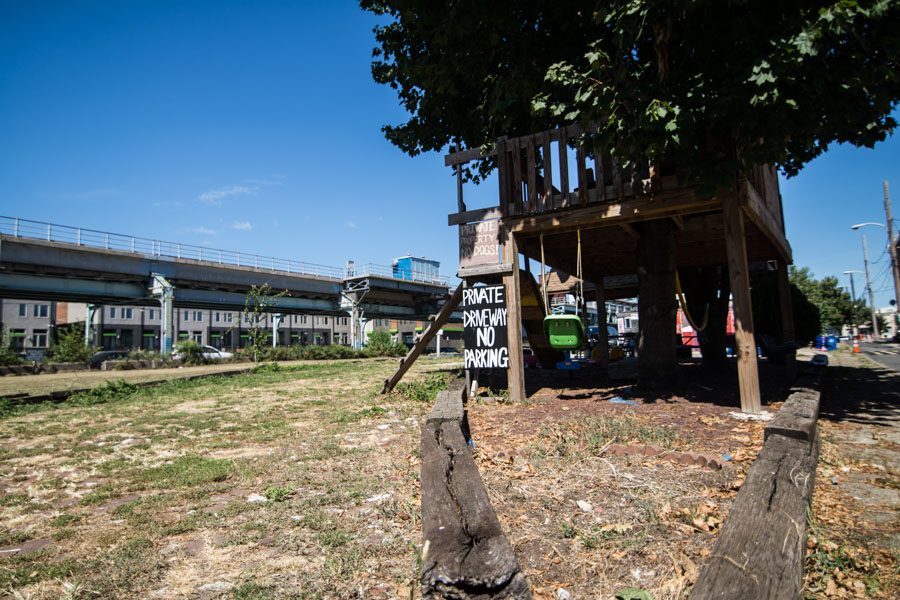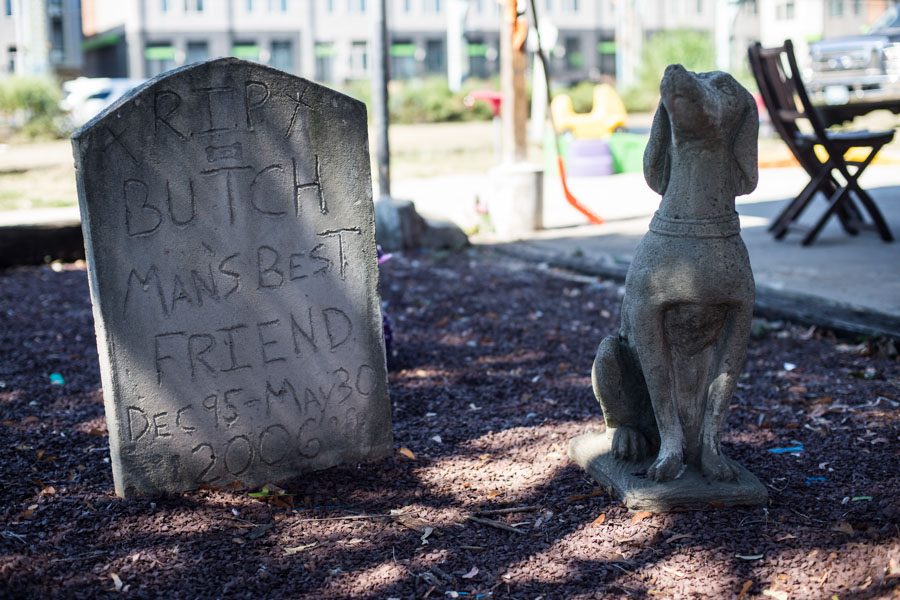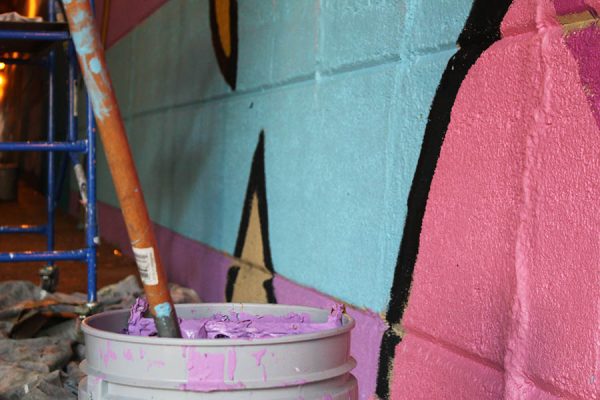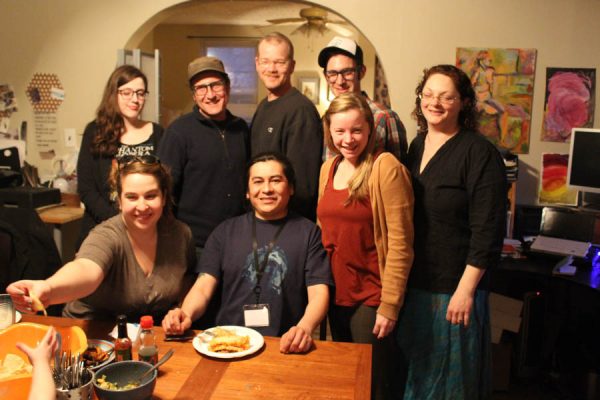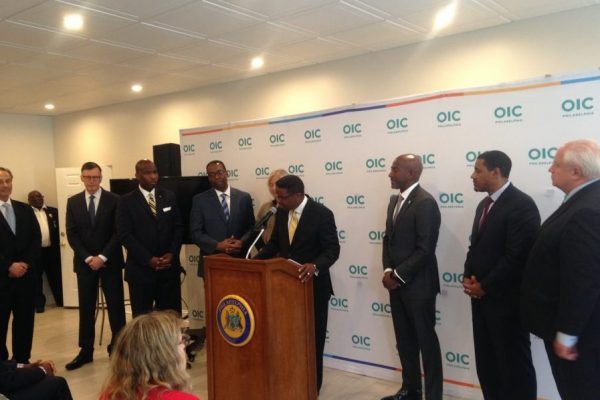The Notorious Galdo Parcel: The City Wants To Sell Land, But This Fishtowner Ain’t Leaving
Legal geeks gather ‘round: Here’s a case that experts in city government and professors at local law schools like Temple’s Beasley School of Law are calling a rarity. So what’s the situation? This case features a local man, Frank Galdo, who started making use of the odd-shaped chunk of a city block in plain sight of anyone riding the El near Front and Girard. He even put up an American flag on the lot to show he wasn’t shy about it.
Galdo is a neighborhood guy who took over the grounds he used as a childhood hangout. From paving a driveway for his work truck, to building a fire pit and hosting parties for his friends in his 20s, to planting trees and then building a treehouse in one of them for his kids, Galdo took over a vacant lot in between the 1100 block of Front Street and the 1100 block of Lee Street and made it his front yard.
“It’s been vacant since I was a kid,” Galdo said, standing on a portion of the lot that he maintains.
Galdo purchased a home on the 1100 block of Lee Street from his grandmother in 1989. He began rehabbing the house and dug out the basement. With the extra concrete from that job he paved a parking space for his work truck on the other side of Lee Street, which is really an alley about six feet wide.
For the next few years Galdo had his friends come over on Friday and Saturday nights for parties. All the while he expanded the parking spot to accommodate his work materials, added in a fire pit, picnic tables, a horseshoe pit and a volleyball court. Galdo even submitted pics of a pig roast as evidence of his occupation of the lot in court. By Philly standards, his tailgates were so fly the Eagles should’ve been playing down the street.
Soon, Galdo picked up two shipping containers from the docks for storing equipment and other materials that a suburbanite might put in their garage. He painted those containers with a patriotic theme and the lot really began developing a unique character.
Galdo then bought the houses next to his in the early 2000s and started knocking down walls for expanded rooms to prepare for a growing family. Today, his kids enjoy the lot, taking advantage of their dad’s handiness with a top-notch tree house. Even though those parties with his friends back in the 90s have been replaced by his kid’s birthday bonanzas, the same policy remains: What happens on the Galdo parcel, stays on the Galdo parcel.
Now, we’ve mentioned how this parcel was vacant and that’s why Galdo decided to take over the plot of land. But what of this lot’s owner? Was anyone going to come and take it back?
Records show the City of Philadelphia as the owner of the property since the mid-1970s. According to other records, the land was condemned under eminent domain to make space for the I-95 project. Originally, the El may have needed re-routing, but it looks like the final use of the space was PennDOT building a shed related to the project. By 1976, the lot was no longer needed by the Commonwealth of Pennsylvania. The City condemned it and took back full responsibility for the property. The timeline of ownership is important.
The only known attention the City gave to the property after the I-95 project was a discussion in the 1970s by council members in which it appeared they intended to sell it. No action was taken then. In 2007 Bart Blatstein expressed enough interest in the lot that then Councilman DiCiccio got the council machine moving toward sale, but that plan stalled and both parties bailed.
A representative from Councilman Mark Squilla’s office acknowledged that recently, “Several developers have expressed interest in the lot.” As to what the developers’ plans are, the rep added, “We haven’t seen any proposals yet.”
Things stayed quiet until one day in 2013 when Galdo came home to find notices on the lot that basically said, “Pack it up and get off the property.” Galdo instead obtained a lawyer and told the City a portion of the property was now his. The legal term for this is “adverse possession.”
Adverse possession is a Pennsylvania law doctrine that permits one to achieve ownership of another’s property by operation of law. One claiming title by adverse possession must prove actual, continuous, exclusive, visible, notorious, distinct, and hostile possession of the land for 21 years.
The Commonwealth is immune from adverse possession claims. Philadelphia is not. The City needs to prove the land was held for public use, or show they were in cahoots with the state.
Adverse possession cases are difficult and the law is actually not specifically designed for a case like Galdo’s. The majority of cases revolve around property boundary disputes between neighbors: misplaced fences not discovered for more than 20 years, shared driveway problems, etc. Galdo actually lost property that way when a neighbor obtained the alley way between their houses.
Temple law professor Jane Baron explains: “The burden of proof is on the person making the claim. They need to show they meet all criteria.”
The basic requirements are that the person possesses the property, meaning you can’t just drive by the land for 21 years and then claim it. You have to be there continuously for the entire 21 year period. That possession needs to be exclusive — not multiple people doing different things. Then there are a few cool words to consider: hostile, open and notorious. Hostile means you don’t have permission from the owner and open and notorious means it’s in plain sight and obvious. These thing all add up to mean that the original owner has neglected the land for decades and had every chance to see that someone took his or her land.
Baron said the law’s purpose is to, “punish negligence and reward diligence.” By any casual observation, Galdo has cared for the land diligently.
Galdo and his legal team presented evidence to prove his occupation of the lot began in 1990, including aerial photos of the lot taken by the Delaware Valley Regional Planning Commission. That organization takes aerial photos of the entire region every five years and they have a picture of his paved parking spot in 1990. Photos taken later capture the improvements in 1995, 2000 and so on.
The lot is in plain view: Anyone riding the El can see it and Galdo never hesitated being loud with his decor. Even the lawyer Spirit News used to walk us through the case exclaimed, “Oh, I know the guy you’re talking about! I used to see his flag from the El.” He further elaborated, “If that guy can prove he was there for 21 years, it’s his lot.”
But the City defeated Galdo in Philadelphia’s Court of Common Pleas.
Our lawyer just said, “Hmm, something’s not right.”
But the mystery may not be solved until Galdo’s appeal is heard.
Common Pleas judge Robert Coleman accepted the City’s argument that it is immune from adverse possession, citing in this case that the City acted as an “agent for the Commonwealth” in first acquiring the property. If the whole “agency” thing sounds exciting to you then take the LSAT this Saturday at your local university, because it’s not. But judges and lawyers can draw out a boring term into multiple hearings and suffice to say they did that here.
Coleman ruled, “Adverse possession can never be established against the Commonwealth or its agents” but Galdo’s team points out that … “no evidence presented at trial that the City acted as an agent of the Commonwealth in condemning the subject Property.” They also added a bunch of other legalese about “coordinate jurisdiction” and one or two other things designed to give a non-lawyer a headache.
Regardless of the official decision, the City had sole title to the property for more than 40 years since January 1976. To give a sense of how long that is, they got the lot the same week the Flyer’s Ed Van Impe crushed Valeri Kharlamov and scared the Russians off the ice, no one in Philly ever heard of a Rocky Balboa, and retired Eagle Donovan McNabb was not born yet. During this entire time the City did not have to consult with the Commonwealth on disposal of the property.
The judge added that the City sufficiently proved that they held the land for public use in that they planned on selling it. Galdo’s lawyers pointed out that other cases ruled that just holding the land is not public use. The City has no record of ever maintaining the lot via lawn care or litter pickup. Spirit News requested documents related to the care of the property on September 2, 2016. The City failed to respond in the allotted five business days that Commonwealth law (you know, their buddies in agency and all) mandates for Right-to-Know requests. Not that it matters as they would have simply responded with a claim that they are taking advantage of the 30 day extension.
Nor did the City act to remove prostitutes or drug dealers from the lot. But as witnesses testified, Galdo did. He kicked out people who were up to no good, he graded the lot with soil, seeded that soil and maintained the land.
Interestingly enough, Judge Coleman did not rule on Galdo’s actual possession of the property, citing that there was no reason to do so since the City was immune adverse possession. That presents a tricky possibility for the appeals court. They could overturn the whole decision or confirm the decision. They could also say Coleman was wrong on the “immunity” and “public use” portions of the decision and send it back to him to fix it.
That could cost a lot of money in legal fees for Galdo, who’s already spent “a boatload of money” on lawyers and has had liens placed on his property to support this legal battle.
Speaking of money, the City’s Office of Property Assessment lists the current value of the property at about $586,800. The City’s “public use” argument was that one day they’d sell the land and the public would get the proceeds. But what if they sold the lot in 1976? The zoning could have been kept industrial or made to be residential. The lot size is sufficient for about 24 properties similar in size to nearby properties. If the lot went for $50,000 back then, or just about $2,000 per residential plot, the value of investing that money in the S&P would give us a value $2,769,711.76. That’s almost five times what the City values the lot at now. Not to mention the 40 years of property taxes that would have been collected.
An email exchange between Bridget Greenwald, Commissioner of Public Property, and John Herzins, Deputy Commissioner of Real Estate, reveals that officials were surprised when Herzins emailed Greenwald and told her the value of the parcel was $586,000. Greenwald replied, “Good Lord! I assume we have no record of us signing any type of agreement for him to use our property?”
Ironically, if the City gave Galdo permission at any point, he’d have no case as his occupation would not be “hostile.”
For now Galdo awaits the decision on his appeal to Commonwealth court. Spirit News will update this story as it progresses. •
